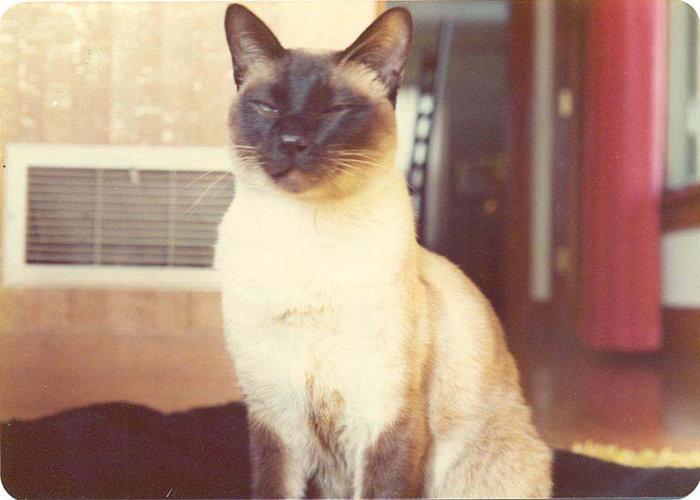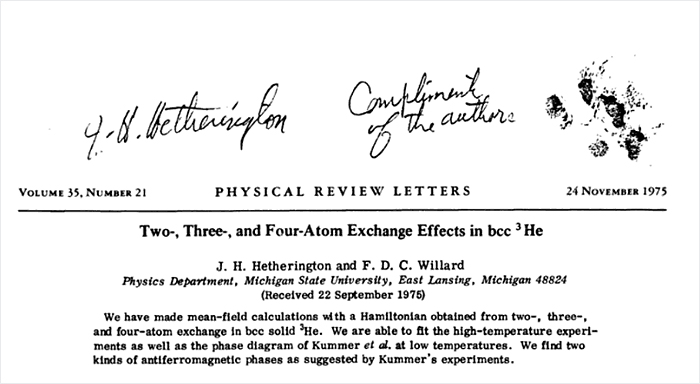
In 1975, This Cat Became A Co-Author Of An Academic Physics Paper On Atomic Behavior At Different Temperatures
Normally, Bored Panda doesn’t cover physics research papers but when it involves a cat as its co-author… you bet there’s going to be an article about it. The physics paper in question was written back in the mid-’70s by Jack H. Hetherington – a professor of physics at Michigan State University.
The academic piece was entitled Two-, Three-, and Four-Atom Exchange Effects in bcc 3He and covered an extensive exploration of atomic behavior at different temperatures. It was a serious paper, which later went on to become very influential and regularly cited writing. Nonetheless, we are more interested in its co-author rather than the content of it, right?
More info: Reddit | Tumblr | Wikipedia
Meet F.D.C. Willard – a co-author of a physics paper published back in 1975
Image credits: unknown
Mr. Hetherington wrote his paper in 1975. As soon as it was ready for publishing and for it to be sent to Physical Review Letters – a scientific journal published by the American Physical Society – the writer wanted it to be reviewed by his friend. Just a last look to see if everything is in all the right places. Then, a problem arose – apparently the professor used “we” throughout the paper.
Hetherington’s colleague who reviewed the academic piece pointed out that Physical Review Letters would normally only publish papers using plural pronouns and adjectives (“we” and “our”) only if the paper had multiple authors – which it didn’t. The problem doesn’t seem so small when you realize that it was written in the ’70s. With a typewriter. There was no easy way to find all the “we’s” and turn them into “I’s”. So, the physics professor found a genius way out of this dilemma.
“I simply asked the secretary to change the title page to include the name of the family cat”
Image credits: Meagan
There were multiple reasons why Mr. Hetherington didn’t want a random co-author on his paper as it was revealed in the book More Random Walks in Science published in 1982. First, the compensation for published writing is changed with each additional author. Second, the scientific writer’s reputation relies on what they publish and can be damaged when several authors are in it.
“Therefore, after an evening’s thought, I simply asked the secretary to change the title page to include the name of the family cat, a Siamese called Chester, sired one summer by Willard. I added the initials F D in front of the name to stand for Felix Domesticus and thus created F.D.C. Willard.”
The physics professor later even issued some article reprints with signatures of both authors
Image credits: R.L. Weber
Depicting F.D.C. Willard as one of the colleagues from Michigan State University, the physics professor submitted his paper to Physical Review Letters, which was published in its issue 35. “Why was I willing do to such an irreverent thing?” Mr. Hetherington hypothetically ponders in the book More Random Walks in Science. “Against it was the fact that most of us are paid partly by how many papers we publish, and there is some dilution of the effect of the paper on one’s reputation when it is shared by another author. On the other hand, I did not ignore completely the publicity value, either. If it eventually proved to be correct, people would remember the paper more if the anomalous authorship were known. In any case, I went ahead and did it and have generally not been sorry.”
“I went ahead and did it and have generally not been sorry”
He further mentions that most people are amused by the fact that his paper’s co-author is a feline, except for the editors. “For some reason, [they] seem to find little humour in the story,” the professor says.
Having revealed the true identity of the co-author, Hetherington even issued some article reprints with signatures of both authors. As you can guess, Willard’s was a pawprint. Apparently, Hetherington found the situation really amusing and would often refer to his beloved cat as the university’s “Rodentia Predation Consultant.”
Here’s what people online thought about the feline author
13Kviews
Share on FacebookCats can change their molecular density at will, so it's perfectly logical that a cat can co-author a physics paper. It's probably titled something like "How I manage to sound like a Shetland pony when I run through the house at night, despite only weighing 10 pounds".
They also constantly study the effects of gravity by subjecting specific objects to falling tests. ♡
Load More Replies...Cats have been studying physics for centuries. Why do you think they keep knocking things off tables?
Load More Replies...Cats can change their molecular density at will, so it's perfectly logical that a cat can co-author a physics paper. It's probably titled something like "How I manage to sound like a Shetland pony when I run through the house at night, despite only weighing 10 pounds".
They also constantly study the effects of gravity by subjecting specific objects to falling tests. ♡
Load More Replies...Cats have been studying physics for centuries. Why do you think they keep knocking things off tables?
Load More Replies...
 Dark Mode
Dark Mode 

 No fees, cancel anytime
No fees, cancel anytime 



























































112
16